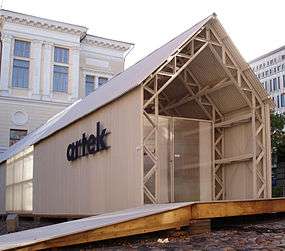Artek (company)

Artek is a Finnish furniture company. It was founded in December 1935 by architect Alvar Aalto and his wife Aino Aalto, visual arts promoter Maire Gullichsen and art historian Nils-Gustav Hahl. The founders chose a non-Finnish name, the neologism Artek was meant to manifest the desire to combine art and technology. This echoed a main idea of the International Style movement, especially the Bauhaus, to emphasize the technical expertise in production and quality of materials, instead of historical-based, eclectic or frivolous ornamentation.[1]
The original aim of the venture was to promote the furniture and glassware of Alvar Aalto and Aino Aalto, and to produce furnishings for their buildings.[2] Before 1935 the Aaltos' designs were manufactured by Huonekalu-ja Rakennustyötehdas Oy in Turku. That company was renamed Huonekalutehdas Korhonen Oy and moved to Littoinen, but now Artek and both companies are all part of Vitra (furniture). Artek have their own in-house designers, the most well-known of the being Ben af Schulten. The studio was originally set up ostensibly to assist Aalto's architects' office with interior designs for his buildings. Since Aalto's death in 1976 the company has sold design objects by other Finnish designers, such as Juha Leiviskä and Eero Aarnio, as well as Vitra furniture.


Representative furniture
Paimio Chair
From the very beginning of his career Alvar Aalto experimented with materials, especially wood, and even applied for patents for the bending of wood as applied in his furniture designs and as acoustic screens in his buildings. The Aaltos designed several different types of furniture and lamps for the Paimio Sanatorium (1929-33). The best known of the furniture pieces is his cantilevered birch wood Paimio Chair, which was specifically designed for tuberculosis patients to sit in for long hours each day. Aalto argued that the angle of the back of the chair was the perfect angle for the patient to breathe most easily. The design of the chair may have been influenced by Marcel Breuer's metal Wassily Chair, though Aalto was generally negative towards metal furniture.[3] The degree of bending of the wood tested the technical limits of that time. The chair is part of the permanent collections at the MoMA in New York City and the Finnish Design Museum.
3 Leg Stool 60
The Model No. 60 stool, designed circa 1932-1933, demonstrated Alvar Aalto's interest in basic functional, utilitarian forms. It was constructed of bent laminated birch, and originally came in all natural (plain) or curled birch, or with a black, red, or blue seat with natural (plain) legs.
3 Leg Stool X600
The X600 evolved from the 60. The handmade legs have the portions attached to the seat opening up into a fan, showing simultaneously the bent wood characteristic of Artek furniture and the fan motif that runs through Aalto's architecture.
Artek Pavilion
In 2007, Japanese architect Shigeru Ban designed an exhibition pavilion for Artek, built from reconstituted waste material provided by the Finnish paper manufacturer UPM. The pavilion was first used at the Milan Triennale in 2007, after which it was temporally in use outside the Design Museum, Helsinki.
References
- ↑ Thomas Kellein (Editor), Alvar & Aino Aalto: Design. Hatje Cantz Publishers, 2005.
- ↑ Göran Schildt, Alvar Aalto. A life's work: Architecture, Design and Art. Otava, Helsinki, 1994
- ↑ Bayley, Stephen, Conran, Terance Design: Intelligence Made Visible. Firefly Books. 2007 pp. 63-64